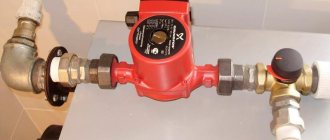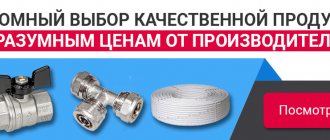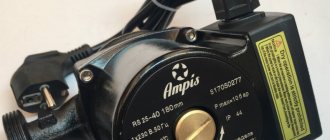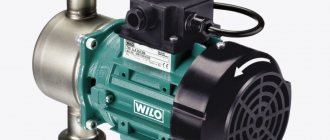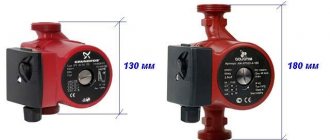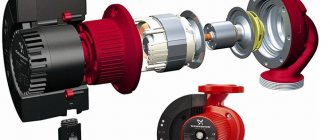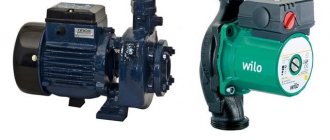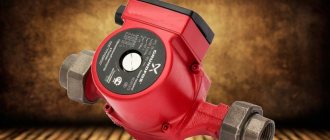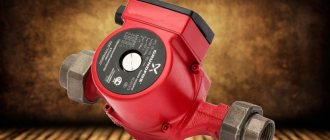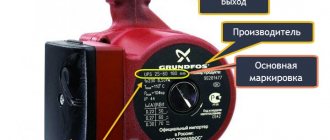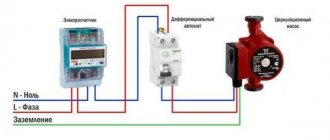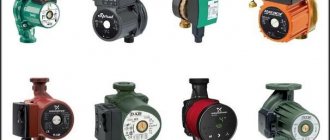What is a circulation pump
The heating circulation pump is a compact device that fits directly into the pipeline of the autonomous heating system. Thanks to an electric motor that drives a spherical rotor with an impeller, such a unit can significantly increase the circulation speed of the coolant in a closed circuit. And this, in turn, makes it possible to accelerate the heating of fairly large areas.
The design of the circulation pump unit can be different, but as a rule, it includes the following main components and parts:
- Electric motor.
- Spherical rotor.
- Stop valve.
- Check valve.
- Frame.
- Thermal insulating casing.
- Thermostat.
- Power supply plug.
In addition, the device can be equipped with an operating status indicator, a timer and some other service devices and instruments.
Prevention and Maintenance
Long service life and trouble-free operation are possible only if proper operating conditions and regular maintenance of the pump are observed. Maintenance means periodic inspection and cleaning of the pump. Inspection for abnormalities in operation should be carried out at least once a quarter, that is, twice during the heating season. It is advisable to perform cleaning every two to three years, depending on the quality of the water and the conditions in which the pump operates.
During the entire period of operation, it is advisable to periodically check the operation of the pump:
- Connections are checked for leaks. If identified, gaskets and seals (tow, FUM tape, etc.) are replaced.
- The presence and condition of grounding is visually checked.
- The sound of a running engine should not be accompanied by clangs, knocks, or extraneous sounds.
- The engine should not vibrate much.
- The pressure in the line is checked and its compliance with the nominal one.
- The housing must be clean and dry. If this is not the case, then you should carry out external cleaning, check the electronic unit for flooding and eliminate the reason why the pump is wet.
Approximately every two to three years, it is advisable to clean the pump, including all its elements. This only applies to models that can be disassembled. There are pumps with a pressed or solid, welded casing that does not require repair or disassembly. Such units fail and are then replaced with a new assembly. It is advisable to entrust this work to a service center. However, if you have the skills and tools, you can do everything yourself
Required:
- hex wrench;
- slotted screwdriver (flat) 4 and 8 mm;
- Phillips screwdriver.
Before disassembling the pump, drain the water from the system or drain a separate area in which the pump is involved, dismantle it and then begin disassembly.
Procedure:
- Using a hex wrench or Phillips screwdriver, unscrew 4-6 bolts around the perimeter of the engine housing at the junction with the shell of the pump part.
- Remove the shell, leaving the impeller on the rotor shaft along with the engine.
- Locate four drainage holes around the perimeter. Using a narrow slotted screwdriver, pry the jacket of the engine compartment under the impeller little by little around the perimeter. As a result, the shaft with the rotor and impeller will come out of the grooves and stator shell. You can help yourself by unscrewing the protective plug on the outside of the pump, inserting a screwdriver into the slot at the end of the shaft and lightly knocking the shaft out of the support bearing.
The analysis is now complete. Now you should clean the surface of the rotor, impeller and the inner surface of the shell from plaque and scale, if any, without damaging the surface of the parts. It is not permissible to use a coarse abrasive. It is better to use a brush with hard polymer bristles. Cleaning products containing a weak solution of hydrochloric acid can help. As a last resort, the finest sandpaper is used - “zero”.
For wet rotor pumps, it is important to check the cleanliness of the channel inside the shaft and the drainage holes located in the protective jacket separating the area of the pump part and the motor. The fluid enters the rotor precisely through these holes and then returns through the internal channel; if they are clogged, engine cooling suffers.
For pumps with a dry rotor, waterproofing the support bearing is important. If a leak is detected from the pump block to the stator block, then all gaskets and seals inside the device should be completely replaced.
The condition of the bearings on which the shaft rests is checked. If they are already quite broken, they will need to be replaced, which is extremely difficult to do at home; you will have to contact a service center.
All seals and gaskets inside the pump should be checked for wear and replaced with new ones if necessary. Once all elements have been cleaned and checked, reassembly is carried out in reverse order.
Circulation pump needs cleaning
Need for use
If in city central heating lines the water pressure is regulated by special centralized substations, then when equipping an autonomous heating and hot water supply system for a country house, a circulation pump device is an absolutely irreplaceable unit. Especially if we are talking about a fairly large building. The fact is that it is capable of “accelerating” the heat supply of a closed circuit in almost any conditions and in any weather.
Without forced circulation, the heating system tends to “heat up” for a very long time. This is especially true in cases where a country house is used not every day, but from time to time. In these cases, a heating circulation heat pump is able to create an optimal microclimate in much less time. Thus, in many cases it is simply impossible to overestimate the value and importance of this unit.
Where to put
It is recommended to install a circulation pump after the boiler, before the first branch, but on the supply or return pipeline it doesn’t matter. Modern units are made from materials that can withstand temperatures up to 100-115°C. There are few heating systems that work with a hotter coolant, so considerations of a more “comfortable” temperature are untenable, but if you feel safer, put it in the return line.
Can be installed in the return or direct pipeline after/before the boiler up to the first branch
There is no difference in hydraulics - the boiler, and the rest of the system; it makes absolutely no difference whether there is a pump in the supply or return branch. What matters is the correct installation, in terms of strapping, and the correct orientation of the rotor in space
Nothing else matters
There is one important point regarding the installation location. If the heating system has two separate branches - on the right and left wings of the house or on the first and second floor - it makes sense to install a separate unit on each, and not one common one - directly after the boiler. Moreover, the same rule remains on these branches: immediately after the boiler, before the first branch in this heating circuit. This will make it possible to set the required thermal conditions in each part of the house independently of the other, and also in two-story houses to save on heating. How? Due to the fact that the second floor is usually much warmer than the first floor and much less heat is required there. If there are two pumps in the branch that goes up, the speed of movement of the coolant is set much lower, and this allows you to burn less fuel, without compromising the comfort of living.
There are two types of heating systems - forced and natural circulation. Systems with forced circulation cannot work without a pump; systems with natural circulation work, but in this mode they have lower heat transfer. However, less heat is still much better than no heat at all, so in areas where electricity is often cut off, the system is designed as hydraulic (with natural circulation), and then a pump is installed into it. This gives high heating efficiency and reliability. It is clear that the installation of a circulation pump in these systems is different.
All heating systems with heated floors are forced - without a pump, the coolant will not pass through such large circuits
Forced circulation
Since a forced circulation heating system without a pump is inoperative, it is installed directly into the gap in the supply or return pipe (of your choice).
Most problems with the circulation pump arise due to the presence of mechanical impurities (sand, other abrasive particles) in the coolant. They can jam the impeller and stop the motor. Therefore, a mesh dirt filter must be placed in front of the unit.
Installing a circulation pump in a forced circulation system
It is also advisable to install ball valves on both sides. They will make it possible to replace or repair the device without draining the coolant from the system. Turn off the taps and remove the unit. Only that part of the water that was directly in this piece of the system is drained.
Natural circulation
The piping of the circulation pump in gravity systems has one significant difference - a bypass is required. This is a jumper that makes the system operational when the pump is not working. One ball shut-off valve is installed on the bypass, which is closed the entire time the pumping is running. In this mode, the system operates as forced.
Installation diagram of a circulation pump in a system with natural circulation
When the electricity goes out or the unit fails, the valve on the jumper is opened, the valve leading to the pump is closed, and the system operates as a gravity system.
Installation features
There is one important point, without which the installation of the circulation pump will require rework: it is necessary to rotate the rotor so that it is directed horizontally. The second point is the direction of flow. There is an arrow on the body indicating which direction the coolant should flow. This is how you turn the unit so that the direction of movement of the coolant is “in the direction of the arrow”.
The pump itself can be installed both horizontally and vertically, just when selecting a model, make sure that it can work in both positions. And one more thing: with a vertical arrangement, the power (pressure created) drops by about 30%. This must be taken into account when choosing a model.
Types of circular heat pumps
Despite the differences in modifications presented on the market today, experts divide them into two main classes:
With a “wet” rotor.
With a “dry” rotor.
As the name implies, the “wet” rotor comes into contact with water circulating in the closed circuit of the heating system. In the vast majority of cases, pumps of this type are installed in country houses, dachas, cottages and other individual housing construction projects.
Among the main advantages of modifications with a “wet” rotor, the following should be highlighted:
- Long service life.
- Unpretentiousness during operation.
- Ease of maintenance and repair.
- Low noise level during operation.
- Compact size and light weight.
- High energy efficiency indicators.
- Relatively affordable price.
However, pumps of this type also have some disadvantages. The main one is the relatively low efficiency rates, amounting to approximately 50% and even lower. That is why, for forced circulation of coolant in heating systems of large areas, the use of a “wet” pump becomes impractical and ineffective.
Autonomous heat supply systems for apartment buildings, residential complexes and large industrial buildings involve the use of devices with a “dry” rotor. The body of such a pump does not come into contact with the coolant, and forced circulation of liquid in the system is carried out using special blades. The efficiency of such a unit can reach 80%. However, the noise emitted by a unit of this type during operation requires not only its installation in a separate room, but also additional soundproofing measures.
Features of dry pumps
“Dry” pumps are used in long-term heating systems and are characterized by the absence of contact of the coolant with the rotor. The main advantage of using such units is considered to be high efficiency (about 80%).
But there are also a lot of disadvantages: the need for a separate soundproofed room where the device will operate due to the high noise level, as well as the importance of controlling dust and suspended particles in the air and heat carriers.
When choosing a dry type pump, please note that they come in 3 types:
- block;
- console (differing in the horizontal position of the engine);
- vertical (the pipes are located in the same axis, and the engine is vertical).
Main characteristics
When choosing a circulation pump for an autonomous heating system, you must pay primary attention to the following technical characteristics:
- Device performance, maximum operating pressure.
- Operating coolant flow rate in cubic meters.
- Unit power.
Obviously, the parameters that the pump must meet largely depend on the characteristics of the autonomous heating system, as well as on the characteristics of the building and structure, the climate zone and many other subtleties and nuances.
Therefore, before choosing a circular heat pump, it is necessary to calculate the required power of the unit.
Unit installation rules
The pump is installed on the coolant circulation circuit in a pipe of a suitable size. Fastening is carried out using complete fittings with additions in the form of measuring instruments - pressure gauge, thermometer and flow sensor. When installing a heating pump, the following rules must be observed:
- Before work, a comprehensive flushing of the pipeline must be performed.
- The mounting point must be in an accessible location for possible inspections and maintenance.
- Shut-off valves are mounted on both sides relative to the pump installation point - at the inlet and outlet.
- During installation, it is important to ensure the correct position of the rotor. According to the instructions, it should occupy a horizontal position, protected from possible deviation. Offsets will cause loss of performance.
- The terminal block must also be open for direct access. In some models of the heating pump, its position can be changed together with the electric motor housing by first unscrewing the mounting screws.
- Installation on long pipelines may involve risks of increased vibrations. In this case, poorly fixed pipe ends are additionally fixed to the supporting structures.
After installation, the quality of the mechanical connections and the correct flow direction are checked. The actual circulation vector must correspond to the arrow of movement of the working medium indicated on the unit body.
Power calculation
Calculating the power of a heat pump is a rather complex process that requires not only sufficiently deep theoretical knowledge and rich practical experience, but also taking into account many aspects and nuances. Therefore, it is most advisable to entrust such calculations to highly qualified specialists. However, there are general principles on the basis of which power can be calculated. True, these calculations will be quite approximate.
There are two calculation methods:
- European. According to it, each square meter of an individual household should receive 100 W of heat, and an apartment complex – 70 W.
- Domestic. For low-rise housing (1-2 floors), it provides for the need to obtain 173 W of heat at a temperature of -25 degrees and 177 at -30. For multi-storey buildings, these indicators are set at 97 and 101 W, respectively.
Of course, in addition to power, the pressure in the system and its configuration itself are also important. That is why it is customary to entrust all calculations to experts from specialized companies. Professionally made calculations allow not only to fully satisfy heat needs, but also to avoid unjustified expenses, as well as unnecessary overloads of the system or, conversely, its idling.
Features of wet pumps
“Wet” pumps are often used in standard private houses, where the length of the pipeline is not very long. The movement of the coolant is accelerated by the rotation of a rotor equipped with an impeller. The mechanism is cooled and lubricated by the fluid inside which the rotor rotates.
An important condition for the normal functioning of a pump of this type is installation taking into account the horizontal position of the shaft. It is this moment that ensures the constant presence of water lubricant supplied to the bearings.
Wet pumps have many advantages:
- energy efficiency;
- noiselessness;
- compact dimensions and light weight;
- durability and reliability;
- ease of installation and repair work;
- complete absence of need for service maintenance.
Wet pumps have a modular design, which is considered extremely convenient when they fail: a damaged module is quickly replaced with a new one, and the problem is considered solved.
There are practically no downsides to this technique. A significant drawback is the low efficiency (only about 50%).
This is due to the impossibility of sealing the rotor, which has a large diameter. Therefore, such equipment is used exclusively in domestic systems with a short length of pipes.
Installation of a heating system circulation pump
It is best to entrust the installation of a circular pump to a heating system, as well as all technical calculations, to qualified specialists. Since installation of a unit with a “wet” rotor involves inserting the device directly into the pipeline, this will require not only theoretical knowledge, but also practical ability to work with specific tools and equipment.
However, we will provide step-by-step instructions for installing a rotary pump in a pipeline.
Selecting a pump installation location
A modern “wet” type circulation pump can be installed in both the return and direct heating branches. Traditionally, the circulation pump is placed in the “return” in front of the boiler in order to:
- Reduce wear and increase the service life of the pump rotor;
- Avoid boiler boiling due to air being drawn out of the boiler by the pump;
- Damage to the pump due to possible boiling of the boiler, especially solid fuel.
Pump diagram in the forward pipeline and Pump diagram in the return pipeline
Step-by-step instruction
Let's start with the fact that if tie-in work is carried out in winter, that is, when uninterrupted operation of the heating system is necessary, then it is necessary to organize a so-called bypass - a temporary workaround that allows the heating system to operate in natural circulation mode.
The basic algorithm for installing the pump itself is as follows:
- It is necessary to pick up the assembled unit and point the marking arrow marked on it towards the heating boiler.
- On the right side, first the filter is screwed on, then the tap, after which a threaded angle with a tee is installed.
- On the left side, the same operations are carried out, with the exception of installing a filter - there is no need for it here.
- After which all that remains is to connect the resulting structure to the pipe, and the pump itself to the power supply.
However, pump installation looks simple and smooth only on paper. As a rule, such work requires cutting pipes, installing ball valves, connecting elements, and sometimes welding. Experienced specialists will cope with this much easier and faster.
Electrical connection of the pump
Due to the fact that water flows through the pump, the electrical power supply circuit of the pump must be protected by an RCD (residual current device) with a cut-off current of 30 mA. You can connect the pump to power:
- Through a socket with a grounding contact and degree of protection IP44;
- Directly, without sockets, using the cable included with the pump or a PVS cable 3×1.5 mm.
©Obotoplenii.ru
Articles on the topic
- Heating system pumps: types and methods of installation of heating circulation pumps
- Home heating: where to choose home heating
- Flushing the heating system: methods for flushing heating
- Marking of circulation pumps for heating systems
- Methods for laying heating pipes
- Heating system with solid fuel boiler for houses over 25 kW
- Methods of heating a private house: choosing how to heat the house
Popular models and prices
As mentioned above, the most common and popular type of circulation pumps for autonomous heating systems in country houses are units with a “wet” rotor. Today there is a wide variety of models from different manufacturers on the market. Depending on the design, technical characteristics and service capabilities, the cost of a circular heat pump can be different amounts.
Today in Moscow you can buy a circulation heat pump as a “budget” version - the cost of such a unit is in the range of 5,500–7,000 rubles. Equipment manufactured under the popular brands Grundfos or Vilo, with such an affordable price, ensures quality, reliability and durability.
There are also more productive models, characterized by high power levels and rich service capabilities in the form of indication of operating parameters, various automatic functions, and so on. The cost of such pumps can reach 12 and 15 thousand rubles.
Types of open systems
Such water heating schemes are divided into types depending on the method of circulation and delivery of coolant to the radiators and its subsequent return back to the boiler. Heated water can move through pipelines in two ways:
- using natural circulation;
- artificial stimulation from the pump.
Due to the design features, there is practically no excess pressure in an open heating system. At the highest point it is equal to atmospheric pressure, and at the lowest it increases slightly due to the hydrostatic effect of the water column. The value of this pressure is small, which makes it possible to organize natural circulation of the coolant. The principle is based on the fact that coolant with different temperatures has different densities, and therefore mass. Example: 1 m3 of water at t = 40 °C weighs 992 kg; after the temperature rises to 60 °C, the mass of 1 m3 drops to 983 kg.
It would seem that the difference is insignificant. Nevertheless, it allows the cooled coolant at a low temperature to displace lighter hot water from the boiler. Natural (convective) circulation occurs in pipelines, and such systems are called gravity or gravitational, because movement in them occurs due to gravity. Therefore, the coolant flow rate in the mains and radiators is low, only 0.1–0.3 m/s. But such schemes are completely energy independent, provided that boilers for an open heating system that do not require electricity work together with them.
Note. In gravity systems, lines are made with increased slopes and pipe diameters.
In order to increase the speed of water flow through the pipes and reduce the heating time of the premises, a pump is built into the main line coming from the boiler. It forces the coolant to move at a speed of 0.3-0.7 m/s, which is why heat transfer occurs more intensely and all branches heat up more evenly. Thanks to the presence of a pump, the distance between the heat source and the batteries can be increased both in length and height.
Installing a pump unit allows you to create a slight excess pressure in the heating system, allowing the coolant to flow well into the radiators. This definitely increases the efficiency of the system as a whole, although it makes it dependent on the availability of electricity.
Note. To ensure that the heating of a private house does not stop when the electricity is cut off, it is customary to install the circulation pump on a parallel bypass line.
Circulation pump ZOX ZX 25-4 180, with nuts
Availability: In stock
Manufacturer: ZOX
Seal
Yandex Market
Description about Circulation pump ZOX ZX 25-4 180, with nuts
The ZOX circulation pump is used to circulate water in open and closed individual heating systems. It should not be used in drinking or sanitary water systems or food liquids.
The following working fluids are allowed for use in circulation pumps: - hot water; — clean, liquid, non-aggressive and non-explosive environments without mineral oils; — liquids with viscosity up to 10 mm/s; - ethylene glycol with a concentration of up to 40%.
— The maximum temperature of the pumped liquid is 110°C; — Maximum ambient temperature — 55°С; — The maximum operating pressure in the system is 10 bar.
Specifications about Circulation pump ZOX ZX 25-4 180, with nuts
| Product group | Circulation pump |
| Series | — |
| Country of origin | China |
| Specifications | |
| Maximum head, m | 4.5/4/3 |
| Power, W | 72/53/3 |
| Capacity, l/min | 48/36/18 |
| Power supply, V/Hz | 220-240/50 |
Brand Article: f517076
Circulation pump ZOX ZX 25-4 180, with nuts, is sold in the Teplosim.ru store (Ulyanovsk) for only 2,035.78 rubles.
For your convenience, we have our own delivery service throughout the city and region.
Delivery to your city by transport companies is also possible.
For detailed delivery conditions, please contact our managers by phone +7-927-270-55-26 or use the delivery information.
If this product is out of stock, you can pre-order.
Circulation pump ZOX ZX 25-4 180, with nuts, as well as other products from the manufacturer ZOX are on sale in our online store Teplosim.ru.
Analysis of installation technology
The installation process itself is quick; to secure the housing, you need to secure two union nuts. This is very convenient for further maintenance and repair work. But before installation, it is necessary to choose the right installation location, otherwise the pump will either work intermittently or will soon fail.
Schemes for inserting a pump into the network
When choosing one of the schemes, it is necessary to take into account the type of heating system, boiler model and ease of maintenance.
Option 1. This is the most common solution: the pump is mounted on the “return”, through which the cooled coolant returns to the boiler. Warm water does not have such an aggressive effect on the parts of the device, so it lasts longer.
A good place for installation is between the membrane tank and the heating boiler. This circuit is universal, it is equally good for open and closed systems, as well as for connecting devices using the collector method (+)
Option 2 . This solution is relevant if for some reason it is not possible to install a pump on the return line. Then it is fixed at the beginning of the circuit, at the supply, but not near the boiler, but after the safety group.
Modern devices can easily withstand high temperatures, but there are still experts who reject such a scheme.
Shut-off valves are ancillary items and are required for quick maintenance. To remove the circulation pump, you need to unscrew the taps located on both sides of the housing (+)
There is such a heating network option as an open system with an expansion tank installed at the highest point of the circuit.
If you install a circulation pump, you will be able to operate it in two modes: natural and forced. Natural circulation will come in handy if there are power outages.
To be able to switch the system from one mode to another, the circulation device is installed not on the pipe, but on the bypass - a special outlet. When the pump is turned on, the pipe is closed with a tap
The last scheme applies only to networks with a solid fuel boiler. The supply pump is not installed due to the risk of explosion. The fact is that with solid fuel boilers it is impossible to quickly stop the heating process, as a result of which the water boils.
Boiling water with steam gets inside the pump, it reduces productivity, the cooled water in the circuit does not have time to flow back into the boiler in the required quantity - and it heats up even more. The result of overheating is an explosion.
A thermal mixing valve becomes an additional element of the network. It serves to switch the coolant circulation from a small circle (with bypass) to a large one (+)
If you run cooled water from the circuit into a heating boiler, condensation will form. To prevent this from happening, the water is first heated in the small circuit to +55°C, and then the thermostatic valve smoothly switches to the large circuit.
As a result, cold water is mixed with already heated water and “temperature shock” does not occur for the boiler.
How piping is done
The circulation pump piping is the equipment necessary for its proper functioning, as well as for the smooth operation of the entire heating system.
First you need to finally decide how many pumps there will be. For one simple circuit, one device is enough, but with complex wiring it is possible to install two or more.
If you plan to use a “warm floor” system in your house or install an indirect heating boiler, then it is better to increase the number of appliances to two. If two boilers are installed - solid fuel and electric - you will also need a separate pump for each unit.
Correct (top) and incorrect (bottom) pump installation options. If you choose the wrong position and move the rotor axis from horizontal, airing or overheating may occur (+)
As mentioned above, ball valves are mandatory elements. They are mounted together with the pump, and in the event of an emergency, they will have to be used.
A check valve made of brass or cast iron is also required so that the coolant moves in one given direction. It is mounted on the pipe immediately after the pump, in the direction of water movement.
A “dirt filter” will be required to prevent solid particles from entering the device housing. Fine filters are not installed in heating circuits. If clean water is needed, it is pre-purified before being poured into the system.
There is a risk of air getting into the network, so there is a need to install an air valve. It can turn on automatically, but there are also manual models.
Using a fitting, a pressure gauge is installed at a short distance from the pump, sometimes two identical devices are installed on both sides. With their help, they monitor the correct operation of the circulation unit
After installing all the devices, the pump is connected to power. A big mistake is to use an ordinary outlet without grounding. This is a safety violation and can cost lives in the event of an accident.
There are smarter ways to power power:
- via uninterruptible power supply (UPS);
- through a differential circuit breaker;
- by connecting to the boiler automation.
The easiest way is to use a circuit breaker: you will need an 8 A switch itself, contacts, and wires. But for practical use, a solution with a thermostat is very convenient.
Connection diagram with thermostat. When the coolant temperature in the network drops below a certain value, the thermostat operates and turns off the power supply (+)
If you plan to install a UPS, you can connect an uninterruptible power supply to both the pump and the boiler at the same time.
Submersible sewage pumps "Oasis"
Submersible fecal pumps are available with the FP marking. These devices successfully cope with pumping out sewage from cesspools and sewer tanks. The devices are capable of diving to a depth of up to 8 m.
Equipped with a 10 m long power cord and automatic float-type water level control. The device body is made of plastic.
The most popular models of the fecal submersible family of units are FP 150 6 and FP 175 7, which have a maximum head of 6m and 7m, respectively.
Having analyzed consumer reviews of pumps of the Oasis brand of various types, we can summarize the following:
- Only 10% of users experienced some problems while using Oasis devices.
- 70% of users were completely satisfied with their choice.
- 20% had no complaints about the devices and received what they expected.
- The main advantages of the units are their quality, reliability, and budget price.
With the correct selection of pumping equipment and its operation in accordance with the instructions developed by the manufacturer, Oasis devices of any type will successfully cope with the tasks assigned to them.
At the same time, the pumps produce a service life much greater than that declared by the manufacturer.
Rules for connecting to power supply
The circulation pump is powered. The connection is standard. It is recommended to install a separate power supply line with a surge protector.
To connect, you need to prepare 3 wires - phase, neutral and ground. You can choose any of the connection methods:
- through a differential machine device;
- connection to the network together with an uninterruptible power supply;
- power supply to the pump from the boiler automation system;
- with thermostat regulation.
Many people wonder why complicate things, because connecting the pump can be done by connecting a plug to a wire.
This is how the pumping device is plugged into a regular outlet. However, experts do not recommend using this method due to the risk of unforeseen situations: there is no grounding and a safety device.
The first option is not difficult to assemble yourself. It is necessary to install an 8 A differential circuit breaker. The wire cross-section is selected based on the device rating.
In the standard scheme, the power supply is carried out to the upper sockets - they are marked with odd numbers, the load - to the lower ones (even numbers). Both phase and neutral will be connected to the machine, so the connectors for the latter are designated by the letter N.
To automate the process of stopping the circulation of the coolant when cooling to a certain temperature, an electrical circuit is used to connect the pump and thermostat.
The second is mounted in the supply line. At the moment when the water temperature drops to the specified value, the device disconnects the electrical supply circuit.
There are no difficulties in supplying electricity through an uninterruptible power supply; it has special connectors for this. A heat generator is also connected to them when there is a need to provide electricity.
If you choose the method of connecting the pump to the boiler control panel or automation, you will need good knowledge of the power supply system or the help of a professional.
About the choice of equipment and the rules for its independent calculation
The key indicator that determines the efficiency of the circulation pump is its power. For a household heating system, there is no need to try to purchase the highest-power installation. It will only make a loud noise and waste electricity.
Mounted circulation pump
You need to correctly calculate the power of the unit based on the following data:
- hot water pressure indicator;
- pipe section;
- productivity and throughput of the heating boiler;
- coolant temperature.
Hot water consumption is determined simply. It is equal to the power indicator of the heating unit. If, for example, you have a 20 kW gas boiler, no more than 20 liters of water will be consumed per hour. The pressure of the circulation unit for the heating system for every 10 m of pipes is about 50 cm. The longer the pipeline, the more powerful the pump you need to purchase. Here you should immediately pay attention to the thickness of the pipe products. The resistance to water movement in the system will be stronger if you install pipes with a small cross-section.
In pipelines with a diameter of half an inch, the coolant flow rate is 5.7 liters per minute at the generally accepted (1.5 m/s) speed of water movement, with a diameter of 1 inch - 30 liters. But for pipes with a cross-section of 2 inches, the flow rate will already be at the level of 170 liters. Always select the diameter of the pipes in such a way that you do not have to overpay extra money for energy resources.
The flow rate of the pump itself is determined by the following ratio: N/t2-t1. In this formula, t1 refers to the temperature of the water in the return pipes (usually it is 65–70 °C), and t2 is the temperature provided by the heating unit (at least 90 °C). And the letter N denotes the boiler power (this value is in the equipment passport). The pump pressure is set according to the standards accepted in our country and Europe. It is believed that 1 kW of power of a circulation unit is quite enough for high-quality heating of 1 square meter of a private home.
Drainage pumps "Oasis"
The Oasis submersible drainage pump with DN marking is used when pumping dirty water from the basement floors of buildings, basements, trenches, ditches, artificial reservoirs or for pumping clean water. Devices are divided into two types - for pumping dirty and clean water.
Drainage pumps Oasis
Units of this type have the following general characteristics:
- maximum diving depth – eight meters;
- electric cable length – 10 m;
- max size of filtered particles, mm: 5 (for DN with clean water), 35 (for DN with dirty water);
- The material of the unit impeller is plastic.
Drainage pumps designed to work with clean water have power parameters ranging from 200 to 660 W, maximum performance of 110 to 220 l/min and maximum head of 6 to 14 m.
The body of these devices is made of plastic. The most common models: DN 110 6, DN 170 9, DN 220 14.
Drainage pumps used for pumping dirty water have power parameters ranging from 110 to 880 W, a maximum flow rate of 150 to 266 l/min and a maximum pressure of 6 to 11 m.
The body of such units is made of plastic or stainless steel. The most popular models: DN 150 6, DN 175 7, DN 266 11.
About installing additional units
As a rule, in a closed or open radiator heating system, where the heat source is a single boiler, it is enough to install one circulation pump.
In more complex schemes, additional units are used for pumping water (there may be 2 or more of them). They are placed in the following cases:
- when more than one boiler installation is used to heat a private house;
- if a buffer tank is involved in the piping scheme;
- the heating system has several branches serving various consumers - radiators, heated floors and an indirect heating boiler;
- the same, using a hydraulic separator (hydraulic arrow);
- for organizing water circulation in underfloor heating circuits.
Correct wiring of several boilers operating on different types of fuel requires that each of them have its own pumping unit, as shown in the diagram for the joint connection of an electric and TT boiler.
In a circuit with a buffer tank, it is necessary to install an additional pump, because it involves at least 2 circulation circuits - boiler and heating.
A separate story is a complex heating scheme with several branches, implemented in large cottages with 2-4 floors. Here, from 3 to 8 pumping devices can be used (sometimes more), supplying coolant floor by floor and to different heating devices.
One-pipe and two-pipe systems
Experts distinguish between two heating schemes with forced circulation of the thermal agent - one-pipe and two-pipe.
The choice of one or another option determines not only the location of the circuits, but also the length of the pipelines, as well as the type and quantity of equipment for shutdown, regulation and control.
A single-pipe heating system is characterized by the sequential inclusion of heating radiators in the circuit. The coolant returns through a separate pipeline to the boiler only after it turns one by one through all the devices of the system.
The disadvantage of this method is that radiators that are closer to the thermal block become warmer than those further away, and this reduces thermal efficiency and equipment life. Introducing a circulation pump into the circuit and equalizing the temperature is achieved at all points of the system.
A two-pipe arrangement has advantages over a single-pipe arrangement, since all heating devices are connected in parallel to the supply and return lines, which promotes uniform temperature distribution throughout all rooms.
Forced circulation of the refrigerant leads to increased efficiency of the system and the ability to regulate its thermal power.
Submersible pumps "Oasis"
Submersible pumps, produced under the Oasis brand, are manufactured for different purposes: well, drainage and fecal.
Downhole deep-well units are marked SN. They are used to supply water that does not contain large solid impurities from various depths.
The maximum depth for the best performance of the unit is 80 m. The diameter of the well for these devices must be at least 90 mm.
The Oasis range of borehole submersible pumps includes units with a capacity of 1 m3 - 15 m3 and a power of 220 - 800 W. Technical parameters depend on the specific SN model.
Downhole units Oasis SN have the following advantages:
- the ability to lift water from great depths;
- durable stainless steel body and parts made from high-quality advanced materials;
- wear-resistant parts determine the durability of the device;
- can pump water with small suspended particles;
- the pressure of the rising water reaches 100 m;
- the device operates without noise;
- the pump does not affect the condition of the pumped water and the well itself.
Advantages of Oasis circulation equipment
- convenience of household use;
- compact placement;
- possibility of temperature adjustment;
- economical energy consumption;
- no energy losses;
- minimal risk of air lock formation;
- no noise;
- easy installation and maintenance of the product;
- affordable price compared to similar manufacturing companies.
The disadvantages boil down only to the low efficiency of such devices.
Pump Maintenance Instructions
The pump surfaces should be cleaned regularly. This is done with a dry cloth or rags. It is important not to damage the sensitive elements, ridding components and small parts of contamination. Aggressive cleaning agents and abrasives should be avoided. If problems are found, you should use the universal repair instructions for heating pumps with a circulating motion effect:
- The unit does not work, although the power is properly connected. This is often the result of a faulty fuse or a broken fuse.
- The heating circuits do not warm up. It is possible that the actual indicators do not correspond to the established values. The heating temperature and flow speed should be increased. If the situation does not change, the control unit is repaired.
- The pump vibrates and makes noise excessively. This is usually the result of too low water pressure. The problem is solved either by increasing the pressure in order to eliminate the effect of cavitation, or by reducing the pressure.
